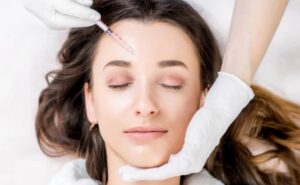Botox injections are a widely sought-after cosmetic treatment designed to reduce the visible signs of aging, such as wrinkles and fine lines. This non-surgical procedure involves injecting a purified form of botulinum toxin into specific muscles of the face. The toxin acts to block the signals responsible for muscle contractions, temporarily relaxing them and smoothing out the skin above.
Injections are effective in treating a variety of age-related concerns, including crow’s feet around the eyes, frown lines between the eyebrows, and forehead wrinkles. The treatment is quick, relatively painless, and requires minimal recovery time. In just a few days, patients can begin to see the smoothing effect of Botox injections. The results typically last between 3-6 months before a follow-up treatment is needed.
Botox injections have become increasingly popular in recent years due to their ability to deliver significant and natural-looking results with minimal risk and downtime. It is important to note that while the procedure is non-surgical, it should only be administered by a qualified and experienced injector to ensure optimal results and avoid potential risks or complications.

How does Botox work?
Botulinum toxin, or botox, is a neurotoxic protein produced by the bacterium Clostridium botulinum. Botox works in cosmetic treatments by blocking the signals that cause muscles to contract, resulting in temporary muscle relaxation. This muscle relaxation can help to smooth out wrinkles and fine lines on the face, making it appear more youthful and refreshed.
Botox’s mechanism of action involves the neurotoxin binding to nerve endings, where it prevents the release of acetylcholine, a neurotransmitter responsible for stimulating muscle contractions. The muscles are unable to contract without the release of acetylcholine, and the skin above the muscle smoothes and becomes less wrinkled.
The effects of Botox injections are typically noticeable within a few days and can last between 3-6 months, depending on the individual and the area of the face being treated. The longevity of the effects can also depend on the dose of Botox injected and the frequency of injections.
In addition to its cosmetic uses, Botox has also been used for medical purposes, including the treatment of chronic migraines, excessive sweating, and muscle spasms. However, it is important to note that Botox injections carry some risks and potential side effects, and should only be administered by a qualified and experienced healthcare professional.
How often should you get Botox injections?
The frequency with which an individual should receive Botox injections is influenced by several factors, including age, wrinkle severity, and lifestyle habits. Because our skin loses elasticity as we age and wrinkles become more visible, older people may require more frequent injections. Another deciding factor is the severity of wrinkles. People with deep wrinkles or significant skin laxity may require more frequent injections to achieve the best results. Furthermore, lifestyle habits such as smoking, excessive sun exposure, and poor nutrition can all contribute to wrinkle formation, potentially necessitating more frequent injections.
Botox injections should be administered every 3-4 months in order to maintain the desired effects. The frequency, however, can vary depending on the individual’s unique circumstances. Some people may require injections every 2 months to maintain the effects of the treatment, while others may be able to go up to 6 months between injections. It is critical to consult with a qualified and experienced injector to determine the best frequency for your specific needs.
Factors that can affect how often you need Botox Several factors can affect how often you need Botox injections. These factors include:
- Age: As we age, our skin becomes less elastic, and wrinkles can become more pronounced. Older individuals may need more frequent injections to maintain the effects of Botox.
- Lifestyle habits: Smoking, excessive sun exposure, and poor nutrition can all contribute to the development of wrinkles. Individuals with these habits may need more frequent injections.
- Severity of wrinkles: Individuals with deep wrinkles or significant skin laxity may need more frequent injections to achieve optimal results.

Signs that you may need Botox injections again
The effects of injections typically last between 3-6 months. Here are some signs that you may need Botox injections again:
- You notice your wrinkles and fine lines are becoming more pronounced.
- You are unable to make the same facial expressions that you could before your last injection.
- You are not getting the same results from your Botox injections as you did previously.
Risks and potential side effects of Botox
Like any cosmetic treatment, injections carry some risks and potential side effects. These may include:
- Pain or discomfort at the injection site
- Swelling or bruising
- Headaches
- Temporary drooping of the eyelid or eyebrow
Tips for finding a qualified and experienced Botox injector
When getting injections, it is important to find a qualified and experienced injector. Here are some tips to help you find the right injector:
- Look for a board-certified dermatologist or plastic surgeon with experience in administering Botox injections.
- Ask for before and after photos of their previous patients.
- Read online reviews and ask for referrals from friends or family members.
Final thoughts on Botox maintenance
In summary, the ideal frequency for injections is unique to each individual and dependent on several factors. Age is one of the primary factors that can impact the frequency of injections required, as older individuals may need more frequent treatments to maintain the effects of Botox. Severity of wrinkles and skin laxity can also affect the frequency of injections needed, as deeper wrinkles or significant skin sagging may require more frequent treatments.
Furthermore, your lifestyle habits can influence how frequently you require injections. Smoking, excessive sun exposure, and poor nutrition can all contribute to wrinkle formation and hasten the breakdown of Botox in the body, necessitating more frequent injections.
Working with a qualified and experienced injector is critical for achieving optimal results while minimizing the risk of potential complications or side effects. Board-certified dermatologists or plastic surgeons with injection experience are usually the most dependable choice for achieving safe and effective results.
Injections can help you maintain a more youthful and refreshed appearance with proper maintenance. Regular follow-up appointments with your injector can help determine the best frequency for injections and ensure that the treatment is effective and long-lasting.
Overall, while the frequency of injections should vary depending on several factors, working with a qualified injector and prioritizing proper maintenance can help you achieve the best results and maintain a more youthful and refreshed appearance for as long as possible.
